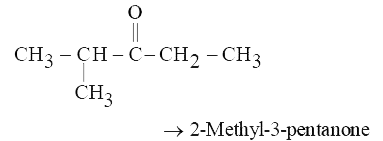In IUPAC system of naming of organic compounds. Which of the following functional group has more preference than other ( in a poly functional compound)
−OH
−CHO
−CO−
−CONH2
The correct Answer is:D
To determine the functional group that has more preference than others in a polyfunctional compound according to the IUPAC system of naming, we need to follow the priority order of functional groups. Here’s a step-by-step solution:
Step 1: Identify the Functional Groups
First, we need to identify the functional groups present in the polyfunctional compound. Common functional groups include:
- Carboxylic acids (-COOH)
- Sulphonic acids (-SO3H)
- Acid derivatives (like esters, amides)
- Aldehydes (-CHO)
- Ketones (R-CO-R')
- Alcohols (-OH)
Step 2: Understand the Priority Order
According to IUPAC nomenclature, functional groups have a specific priority order when naming polyfunctional compounds. The priority order is as follows:
1. Carboxylic acids
2. Sulphonic acids
3. Acid derivatives (like esters and amides)
4. Aldehydes
5. Ketones
6. Alcohols
Step 3: Determine the Highest Priority Functional Group
From the priority order, we can see that the carboxylic acid group has the highest preference. Therefore, if a compound contains a carboxylic acid along with other functional groups, the carboxylic acid will take precedence in naming the compound.
Step 4: Conclusion
In a polyfunctional compound, the functional group with the highest preference is the carboxylic acid group.
First, we need to identify the functional groups present in the polyfunctional compound. Common functional groups include:
- Carboxylic acids (-COOH)
- Sulphonic acids (-SO3H)
- Acid derivatives (like esters, amides)
- Aldehydes (-CHO)
- Ketones (R-CO-R')
- Alcohols (-OH)
According to IUPAC nomenclature, functional groups have a specific priority order when naming polyfunctional compounds. The priority order is as follows:
1. Carboxylic acids
2. Sulphonic acids
3. Acid derivatives (like esters and amides)
4. Aldehydes
5. Ketones
6. Alcohols
From the priority order, we can see that the carboxylic acid group has the highest preference. Therefore, if a compound contains a carboxylic acid along with other functional groups, the carboxylic acid will take precedence in naming the compound.
In a polyfunctional compound, the functional group with the highest preference is the carboxylic acid group.
Topper's Solved these Questions
- BOOK - NARAYNACHAPTER - SOME BASIC PRINCIPLES AND TECHNIQUESEXERCISE - EXERCISE - I (H.W) (STRUCTURAL ISOMERISM )6videos
SOME BASIC PRINCIPLES AND TECHNIQUES
- BOOK - NARAYNACHAPTER - SOME BASIC PRINCIPLES AND TECHNIQUESEXERCISE - EXERCISE - I (H.W) (CLEAVAGE OF BONDS AND ELECTRONIC DISPLACEMENTS )7videos
SOME BASIC PRINCIPLES AND TECHNIQUES
- BOOK - NARAYNACHAPTER - SOME BASIC PRINCIPLES AND TECHNIQUESEXERCISE - EXERCISE - I (H.W) (INTRODUCTION, TETRAVALENCE OF CARBON, STRUCTURAL REPRESENTATION OF ORGANIC COMPOUNDS)13videos
SOME BASIC PRINCIPLES AND TECHNIQUES
- BOOK - NARAYNACHAPTER - SOME BASIC CONCEPTS OF CHEMISTRYEXERCISE - EXERCISE - IV43videos
SOME BASIC CONCEPTS OF CHEMISTRY
- BOOK - NARAYNACHAPTER - STATES OF MATTEREXERCISE - A & R TYPE QUESTIONS16videos
STATES OF MATTER
Similar Questions
Knowledge Check
- Question 1 - Select One
Which of the following compound has the functional group −OH
A1, 2-ethandiolB2-butanoneCNitrobenzeneDEthanal - Question 2 - Select One
Which of the following compound has wrong IUPAC name?
ACH3CH2−CH2COO−CH2CH3 (Ethyl butanoate)BCH3−CH∣CH3−CH2−CHO (3−Methylbutanal)CCH3−CH∣OH−CH∣CH3−CH3 (2−Methyl−3−butanol)DCH3−CH∣CH3−C∣∣O−CH2−CH3 (2−Methyl−3−pentanone) - Question 3 - Select One
Which of the following compound has wrong IUPAC name?
ACH3−CH2−CH2−COO−CH2CH3→ ethyl butanoateB C
C D
D
Naming of Compounds having more than One type of Functional Groups
View SolutionNaming OF Poly Functional Groups
View Solutionwhich of the following compound has maximum functional group?
View SolutionWhich of the following IUPAC name of compound?
 View Solution
View SolutionCompounds containing which of the following functional groups can exhibit geometrical isomerism ?
View Solution

